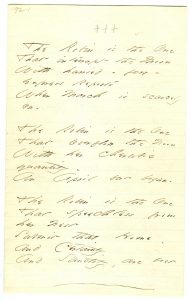 The Robin is the One
The Robin is the One
That interrupt the Morn
With hurried – few –
express Reports
When March is scarcely
on –
The Robin is the One
That overflow the Noon
With her cherubic
quantity –
An April but begun –
The Robin is the One
That speechless from
her Nest
Submit that Home –
and Certainty
And Sanctity, are best
Link to EDA manuscript. Originally in Amherst Manuscript #set 92. Courtesy of Amherst College, Amherst, MA. First published by Higginson, Atlantic Monthly, 68 (October 1891), 450, from his copy ([B]); also Poems (1891), 117.
Dickinson sent this poem about spring to Susan Dickinson around 1863, but it was lost; she transcribed the copy in Set 92 around late 1865. It is written in the short hymn meter, with lines of 6686 syllables and a rhyme scheme of aaba coordinated by the repetition of the word “one” in the first line of each stanza. The poem is also notable for using a plural verb for a doubly singular noun: “Robin” and “one.” Dickinson employs this technique to produce a startling effect in other poems: for example, “a myriad Daisy” in “In lands I never saw – they say” (F108A, J124) and “I wish I were a Hay” in “The grass so little has to do” (F379A, J333)
Here, the Robin is indelibly linked to spring, to March and April, to singing, and also “speechlessness.” Is there a slightly resentful tone in the last stanza, in which the “speechless” Robin smugly
submit that Home
and Certainty
And Sanctity, are best
Could the curious doubling of the verbs invoke Dickinson and Susan, the dear friend and poetic interlocutor whom Dickinson often represents as a bird, and could it allude to Susan’s silence and preoccupation at this time with home and children, a “certainty” Dickinson would never have in the same way again?
Sources
Lair, Robert L. “Emily Dickinson’s Fracture of Grammar: Syntactic Ambiguity in Her Poems.” The Analysis of Literary Texts: Current Trends in Methodology. Ed. Randolph D. Pope. Ypsilanti, MI: Bilingual/Editorial Bilingüe, 1980, 158-64, 163.

